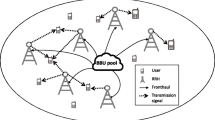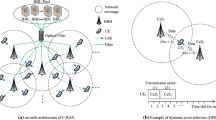Abstract
Cloud radio access network (Cloud-RAN) is recognized as one of the key enabling techniques for 5G due to its advantages in flexibility. In addition, the greatly increased energy efficiency (EE, evaluated by bits/Hz/J) is listed as one main objective when designing 5G wireless network. In this paper, we concentrate on EE optimization through Cloud-RAN enabled flexible multicell cooperative transmission. A joint clustering and beamforming problem for EE optimization is formulated. Due to the combinatorial nature of the clustering process and the non-convexity of the energy efficient beamforming design, the problem is difficult to solve directly. Therefore, we propose a hierarchical iterative framework to solve the problem. The origin optimization problem is decoupled into two subproblems, i.e., energy efficient beamforming problem and energy efficient cluster forming problem. Coalition formation game theory and fractional programming are utilized to obtain the optimal network cluster partition and beamformers respectively. Simulation results demonstrate the superior performance of the proposed algorithms.










Similar content being viewed by others
References
Bhushan N, Li J, Malladi D, Gilmore R, Brenner D, Damnjanovic A, Sukhavasi R, Patel C, Geirhofer S (2014) Network densification: the dominant theme for wireless evolution into 5g. IEEE Commun Mag 52(2):82–89
Zhang H, Chu X, Guo W, Wang S (2015) Coexistence of wi-fi and heterogeneous small cell networks sharing unlicensed spectrum. IEEE Commun Mag 53(3):158–164
Chih-Lin I, Rowell C, Han S, Xu Z, Li G, Pan Z (2014) Toward green and soft: a 5g perspective. IEEE Commun Mag 52(2):66–73
Soret B, Hua W, Pedersen KI, Rosa C (2013) Multicell cooperation for lte-advanced heterogeneous network scenarios. IEEE Wirel Commun 20(1):27–34
Zhang H, Jiang C, Beaulieu NC, Chu X, Wang X, Quek TQS (2015) Resource allocation for cognitive small cell networks: A cooperative bargaining game theoretic approach. IEEE Trans Wirel Commun 14 (6):3481–3493
Somekh O, Simeone O, Bar-Ness Y, Haimovich AM, Shamai S (2009) Cooperative multicell zero-forcing beamforming in cellular downlink channels. IEEE Trans Inf Theory 55(7):3206–3219
Zhang H, Jiang C, Cheng J, Leung V C M (2015) Cooperative interference mitigation and handover management for heterogeneous cloud small cell networks. IEEE Wirel Commun 22(3):92–99
Pennanen H, Tolli A, Kaleva J, Komulainen P, Latva-aho M (2016) Decentralized linear transceiver design and signaling strategies for sum power minimization in multi-cell mimo systems. IEEE Trans Signal Process 64(7):1729–1743
Pompili D, Hajisami A, Tran TX (2016) Elastic resource utilization framework for high capacity and energy efficiency in cloud ran. IEEE Commun Mag 54(1):26–32
Zhang H, Jiang C, Beaulieu NC, Chu X, Wen X, Tao M (2014) Resource allocation in spectrum-sharing ofdma femtocells with heterogeneous services. IEEE Trans Commun 62(7):2366–2377
Mahapatra R, Nijsure Y, Kaddoum G, Ul Hassan N, Chau Y (2016) Energy efficiency tradeoff mechanism towards wireless green communication: A survey. IEEE Commun Surv Tutorials 18(1):686–705
Andrews JG, Buzzi S, Choi W, Hanly SV, Lozano A, Soong ACK, Zhang JC (2014) What will 5g be IEEE J Sel Areas Commun 32(6):1065–1082
Heliot F, Imran MA, Tafazolli R (2011) Energy efficiency analysis of idealized coordinated multi-point communication system. In: 2011 IEEE 73rd Vehicular Technology Conference (VTC Spring), pages 1–5
Lozano A, Heath RW, Andrews JG (2013) Fundamental limits of cooperation. IEEE Trans Inf Theory 59(9):5213–5226
Baracca P, Boccardi F, Braun V (2012) A dynamic joint clustering scheduling algorithm for downlink comp systems with limited csi. In: 2012 International Symposium on Wireless Communication Systems (ISWCS), pages 830–834
Haijun Z, Hui L, Chunxiao J, Xiaoli C, Nallanathan A, Xiangming W (2015) A practical semidynamic clustering scheme using affinity propagation in cooperative picocells. IEEE Trans Veh Technol 64(9):4372–4377
Saad W, Han Z, Debbah M, Are H, BaÅar T (2009) Coalitional game theory for communication networks. IEEE Signal Process Mag 26(5):77–97
Zengfeng Z, Lingyang S, Zhu H, Saad W (2014) Coalitional games with overlapping coalitions for interference management in small cell networks. IEEE Trans Wirel Commun 13(5):2659–2669
Zhongyuan Z, Mugen P, Zhiguo D, Chonggang W, Poor HV (2015) Cluster formation in cloud-radio access networks: Performance analysis and algorithms design. In: 2015 IEEE International Conference on Communications (ICC), pages 3903–3908
He S, Huang Y, Yang L, Ottersten B, Hong W (2015) Energy efficient coordinated beamforming for multicell system: Duality-based algorithm design and massive mimo transition. IEEE Trans Commun 63(12):4920–4935
Wei X, Yuke C, Hua Z, Ye Li G, Xiaohu Y (2015) Robust beamforming with partial channel state information for energy efficient networks. IEEE J Sel Areas Commun 33(12):2920–2935
Nie W, Zheng FC, Wang X, Zhang W, Jin S (2016) User-centric cross-tier base station clustering and cooperation in heterogeneous networks: Rate improvement and energy saving. IEEE J Sel Areas Commun 34 (5):1192–1206
Garcia V, Yiqing Z, Jinglin S (2014) Coordinated multipoint transmission in dense cellular networks with user-centric adaptive clustering. IEEE Trans Wirel Commun 13(8):4297–4308
Dong L, Qian Z, Shengqian H, Chenyang Y, Gang W, Ming L (2014) Semi-dynamic cooperative cluster selection for downlink coordinated beamforming systems. In: 2014 IEEE Wireless Communications and Networking Conference (WCNC), pages 1194–1199
Liu D, Han S, Yang C, Zhang Q (2015) Semi-dynamic user-specific clustering for downlink cloud radio access network. IEEE Trans Veh Technol PP(99):1–1
Ramamonjison R, Haghnegahdar A, Bhargava VK (2014) Joint optimization of clustering and cooperative beamforming in green cognitive wireless networks. IEEE Trans Wirel Commun 13(2):982–997
Binbin D, Wei Y (2014) Sparse beamforming and user-centric clustering for downlink cloud radio access network. IEEE Access 2:1326–1339
Yuanming S, Jun Z, Letaief KB (2014) Group sparse beamforming for green cloud-ran. IEEE Trans Wirel Commun 13(5):2809–2823
Hong M, Sun R, Baligh H, Luo Z-Q (2013) Joint base station clustering and beamformer design for partial coordinated transmission in heterogeneous networks. IEEE J Sel Areas Commun 31(2):226–240
Yoon M, Kim MS, Lee C (2016) A dynamic cell clustering algorithm for maximization of coordination gain in uplink coordinated system. IEEE Trans Veh Technol 65(3):1752–1760
Rahman MMU, Ghauch H, Imtiaz S, Gross J Rrh clustering and transmit precoding for interference-limited 5g cran downlink. In: 2015 IEEE Globecom Workshops (GC Wkshps), pages 1–7. IEEE, p 2015
Pantisano F, Bennis M, Saad W, Verdone R, Latva-aho M On the dynamic formation of cooperative multipoint transmissions in small cell networks. In: Globecom Workshops (GC Wkshps), 2012 IEEE, pages 1139–1144
Qingjiang S, Razaviyayn M, Zhi-Quan L, Chen H (2011) An iteratively weighted mmse approach to distributed sum-utility maximization for a mimo interfering broadcast channel. IEEE Trans Signal Process 59 (9):4331–4340
Dinkelbach W (1967) On nonlinear fractional programming. Manag Sci 13(7):492–498
Jagannathan R (1966) On some properties of programming problems in parametric form pertaining to fractional programming. Manag Sci 12(7):609–615
Hong M, Sun R, Baligh H, Luo Z-Q (2013) Joint base station clustering and beamformer design for partial coordinated transmission in heterogeneous networks. IEEE J Sel Areas Commun 31(2):226–240
Apt KR, Witzel A (2009) A generic approach to coalition formation. International Game Theory Review 11(03):347–367
Soret B, Pedersen KI, Jorgensen NTK, Fernandez-Lopez V (2015) Interference coordination for dense wireless networks. IEEE Commun Mag 53(1):102–109
Apt KR, Radzik T (2006) Stable partitions in coalitional games. arXiv preprint cs/0605132
Lo TKY (1999) Maximum ratio transmission. In: 1999 IEEE International Conference on Communications, 1999. ICC ’99, volume 2, pages 1310–1314 vol 2
Ngo HQ, Larsson EG, Marzetta TL (2013) Energy and spectral efficiency of very large multiuser mimo systems. IEEE Trans Commun 61(4):1436–1449
Acknowledgment
This work is supported by the National Natural Science Foundation of China , No. 61271179, and the Beijing Municipal Science and Technology Commission research fund project “Research on 5G Network Architecture and Its Intelligent Management Technologies”, No. D151100000115002.
Author information
Authors and Affiliations
Corresponding author
Rights and permissions
About this article
Cite this article
Chen, Y., Wen, X., Lu, Z. et al. Energy Efficient Clustering and Beamforming for Cloud Radio Access Networks. Mobile Netw Appl 22, 589–601 (2017). https://doi.org/10.1007/s11036-016-0768-7
Published:
Issue Date:
DOI: https://doi.org/10.1007/s11036-016-0768-7




